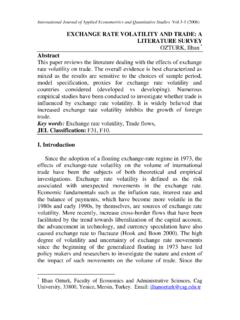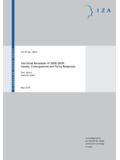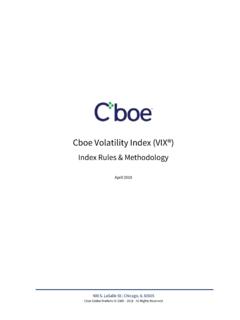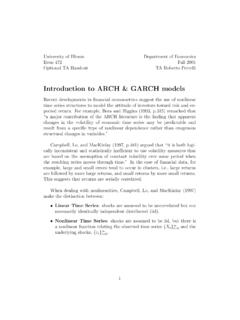Transcription of Price Volatility in Global Food and Agricultural Markets
1 Price Volatility in Food and Agricultural Markets : Policy Responses Policy Report including contributions by FAO, IFAD, IMF,OECD, UNCTAD, WFP, the World Bank, the WTO, IFPRI and the UN HLTF. 2 June 2011. UN-HLTF on Global Food Security Price Volatility IN FOOD AND Agricultural Markets : POLICY RESPONSES 3. G20 leaders at their summit meeting in November 2010 requested FAO, IFAD, IMF, OECD, UNCTAD, WFP, the World Bank and the WTO (to) work with key stakeholders to develop options for G20 consideration on how to better mitigate and manage the risks associated with the Price Volatility of food and other agriculture commodities, without distorting market behaviour, ultimately to protect the most vulnerable.. The preparation of this report, coordinated by the FAO and the OECD, has been undertaken in a truly collaborative manner by FAO, IFAD, IMF, OECD, UNCTAD,WFP, the World Bank, the WTO, IFPRI and the UN HLTF. We, the international organisations, are honoured to provide you with this joint report and look forward to continuing collaboration within the G20 framework to further elaborate and, as appropriate, implement the recommendations of the international organisations that it contains.
2 2 June 2011. 3. Price Volatility IN FOOD AND Agricultural Markets : POLICY RESPONSES 5. Table of Contents 1. Introduction .. 6. Scope .. 6. What is Volatility ? .. 6. Trends in Volatility .. 7. Volatility in Global versus national Markets .. 8. 2. Price Volatility in food and agriculture, potential developments and 9. The determinants of future increases in food prices and of Volatility .. 10. Why does Agricultural Price Volatility matter? .. 12. Lessons learned from recent experiences .. 13. 3. Measures to increase productivity, sustainability and resilience of agriculture .. 15. 4. Policy options to reduce Price Volatility .. 18. Market information, transparency and policy response .. 18. International food stocks .. 21. Futures Markets .. 21. Domestic and trade policies .. 24. Dealing with waste .. 28. 5. Policy options to deal with the consequences of Price Volatility , particularly for the most vulnerable .. 28. Coping with Volatility in the short run: buffer stocks, emergency food reserves, international and national safety nets.
3 28. Coping with Volatility in the short run: international and national safety nets .. 30. Coping with Volatility in the long run: market-based mechanisms to protect producers against Price and other risks and to stabilize food import bills .. 33. 6. Improving international policy coordination in relation to food Price Volatility : market information and policy responses .. 36. Annex A. Definition of Volatility and related terms .. 43. Annex B. Food Price Volatility and food security the role of smallholders in developing 44. Annex C. Increasing the productivity, sustainability and resilience of agriculture in developing and emerging economies .. 48. Annex D. Introducing flexibility into policy driven demand for Agricultural feed stocks for biofuel production .. 55. Annex E. Emergency humanitarian food reserves to support safety nets in poor countries .. 58. Annex F. A code of conduct for responsible emergency food reserves management.
4 65. Annex G. Risk management activities and instruments .. 67. 5. 6 Price Volatility IN FOOD AND Agricultural Markets : POLICY RESPONSES. 1. Introduction Scope 1. Under the Food Security pillar of the Seoul Multi-year Action Plan on Development, the G20. request that FAO, IFAD, IMF, OECD, UNCTAD, WFP, the World Bank and the WTO work with key stakeholders to develop options for G20 consideration on how to better mitigate and manage the risks associated with the Price Volatility of food and other agriculture commodities, without distorting market behaviour, ultimately to protect the most vulnerable . This report has been prepared by FAO, IFAD, IMF, OECD, UNCTAD,WFP, the World Bank, the WTO, IFPRI and the UN HLTF. 2. The approach taken in this report reflects the view of the collaborating international organisations that Price Volatility and its effects on food security is a complex issue with many dimensions, Agricultural and non- Agricultural , short and long-term, with highly differentiated impacts on consumers and producers in developed and developing countries.
5 The report begins with a discussion of Volatility and of the ways in which Volatility affects countries, businesses, consumers and farmers. Lessons learned from recent experiences are briefly reviewed as well as the factors determining likely levels of Volatility in future. This report offers suggestions for a systematic and internationally coordinated response building on the lessons learned as a result of the 2007-2008crisis. 3. It is important to distinguish between policy options designed to prevent or reduce Price Volatility and those designed to mitigate its consequences. Both types of intervention are explored in detail. Scope is identified for actions at individual, national, regional and international level. Some would help to avert a threat, others are in the nature of contingency plans to improve readiness, while still others address long-term issues of resilience. Finally, the report explores mechanisms of international cooperation to implement this report s recommendations and to monitor What is Volatility ?
6 4. In a purely descriptive sense Volatility refers to variations in economic variables over time, (more technical definitions of Volatility and related terms are put forward in Annex A) Here we are explicitly concerned with variations in Agricultural prices over time. Not all Price variations are problematic, such as when prices move along a smooth and well-established trend reflecting market fundamentals or when they exhibit a typical and well known seasonal pattern. But variations in prices become problematic when they are large and cannot be anticipated and, as a result, create a level of uncertainty which increases risks for producers, traders, consumers and governments and may lead to sub-optimal decisions. Variations in prices that do not reflect market fundamentals are also problematic as they can lead to incorrect decisions. These implications of Volatility will be explored in detail in Chapter 2. 5. Behind concerns about Volatility lie concerns about Price levels and behind both, lie concerns about food security.
7 While producers benefit (or at least those who are net producers and whose asset base and knowledge enable them to respond effectively), consumers, especially poor consumers, are severely adversely affected by high prices2. Food accounts for a very high share of the total budget of the poorest households. And because poor households often consume foods that are less processed the effect of rises in commodity prices is felt more strongly. These households find their nutrition status (especially of pregnant women, children and those affected by long-term diseases such as HIV), as well as their capacity to purchase education, health care, or other basic needs compromised, when food prices are high. 6. Producers are more concerned about low prices, which may threaten their living standards as well as their longer term viability when income is too low to provide for the farm family or for the 6. Price Volatility IN FOOD AND Agricultural Markets : POLICY RESPONSES 7.
8 Operational needs of the farm. Uncertainty may result in less than optimal production and investment decisions3. In developing countries, many households are both producers and purchasers of Agricultural products. For this group the impacts of Price Volatility are complex, with net outcomes depending on a combination of many 7. No attempt is made here to define extreme or excessive Price Volatility . Suffice it to say that Volatility becomes an issue for concern and for possible policy response when it induces risk averse behaviour that leads to inefficient investment decisions and when it creates problems that are beyond the capacity of producers, consumers or nations to cope. What constitutes excessive Volatility depends very much on the situation of the individual or nation. Poor consumers in less developed countries without access to adequate social support are most immediately affected by Price surges. Small resource limited farmers face particularly severe problems when prices fall.
9 The episode of Volatility that occurred during the 2007-2008 period, resulted in poor, vulnerable consumers and producers and poorer developing countries dependent on food imports experiencing severe economic, social and political stress because of high prices and fears of scarcity. Lessons learned concerning appropriate national and international response are instructive as we enter 2011 with many commodity prices again increasing sharply. Trends in Volatility 8. When looked at in the long term there is little or no evidence that Volatility in international Agricultural commodity prices, as measured using standard statistical measures is increasing and this finding applies to both nominal and real prices5. Volatility has, however, been higher during the decade since 2000 than during the previous two decades and this is also the case of wheat and rice prices in the most recent years (2006-2010) compared to the nineteen Another conclusion that emerges from the study of long term trends in Volatility is that periods of high and volatile prices are often followed by long periods of relatively low and stable prices.
10 Finally, it is well established that Agricultural Markets are intrinsically subject to greater Price variation than other Markets , for reasons that are outlined in the introduction to Chapter 2. 9. International commodity prices since 1970 are presented in Figure 1 and commodity Price movements during the past decade as shown in Figure 2. Figure 1. Agricultural commodity prices in real terms Figure 2. Monthly commodity Price indices (2005=100) (2002-04=100). IMF food Index Beef Butter Maize Rice Wheat 1000. Food Prices Meat Dairy Sugar Wheat Rice 800. 900. 700. 800. 600 700. 600. 500. 500. 400. 400. 300. 300. 200. 200. 100. 100. 0. 0. 10. Since 1990, as shown in Figure 3, the implied Volatility for major crops has increased Implied Volatility reflects the expectations of market participants on how volatile prices will be and is measured as a percentage of the deviation in the futures Price (six months ahead) from underlying expected value (for a more detailed explanation of implied Volatility see Annex A).



















